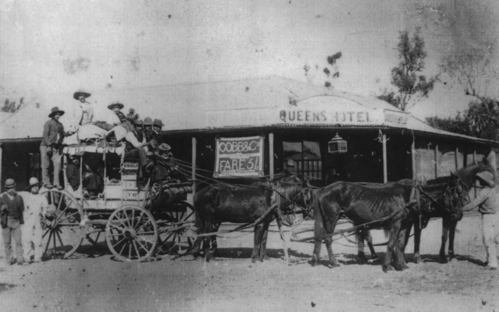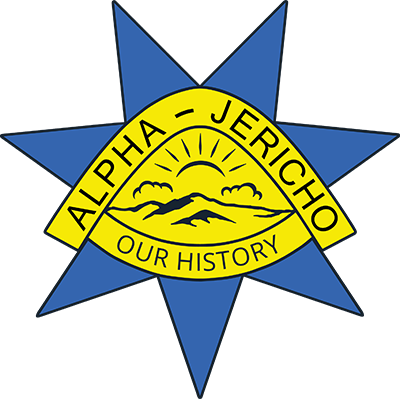
Cobb & Co coach at Queens Hotel, Jericho
In November 1889, Francis Doherty, licensee of the Queens Hotel in Jericho was the first man to select a small (320 acres) block of land within the Alpha-Jericho districts. As the licensee of the hotel from 1888, he was interested in leasing an area where carriers and other clients could hold horses, when the stables at the hotel were unable to hold them all. He applied for a further 320 acres in neighbouring blocks during the following year.
He quickly employed a fencer to enclose the blocks but, either to gain advantage of an additional water supply from a temporary water hole or as a genuine misunderstanding of the survey lines, he included part of a gazetted reserve in his land. In a local Court, he was fined 20 shillings and allowed time to remove the fence.[i]
Conditions for gaining a lease on these small selections also included residence on one of the blocks. Francis Doherty built a small hut worth £12 before 1895 and excavated a dam worth £10. As an hotelier in town, it is unlikely that he actually spent many nights in the hut himself. However he employed bailiffs; Robert Taylor to reside there for a year from April 1872, and Ralph Walkinshaw from June to September 1895, when the selection was inspected to establish whether conditions had been sufficiently met for a lease to be granted. His advice about residence was accepted and the lease granted from 30 January 1896.
After Francis’ death in 1904, the selections were sold to William Hawkins, also a Jericho hotelier.
Francis Doherty’s land use provides an example of the towns’ business men and women selecting a small area of land close to town. At 20% of the first selectors, this group included hotel licensees, butchers and storekeepers. Each used the land for grazing animals to support their businesses.
At 36%, the largest group included the men and women with connections to pastoral industries, in particular carriers. This land provided a valuable base for the teams of horses they used in this part of Queensland to transport goods to properties for pastoral families, returning with wool to the railheads. This group of selectors also included family members of the men who wished to extend the area they held.
The second largest group of selectors (25%) came from railway workers who had remained in the districts to maintain and operate the railway – gangers, lengthsmen, engine driver and guard. For some of these families, these selections lead to occupational change as landowners, several families remaining in the district for many years.
The occupation of about 14% of the selectors was not reported on their applications.
These small selections were offered in the belief held by Lands Department officials and some local people that farming would be possible within the area. However, the early twentieth century drought, the ongoing limited access to water and the shortage of local markets meant that any dreams of agriculture disappeared in following decades. Selections continued to be used to support the grazing industry, many by being absorbed into the adjacent extensive grazing properties.
[i] Doherty, Francis and others, Barcaldine 328 and 41, Items ID2439047 and ID2438804, Series 14050 Dead Farm Files, Queensland State Archives.
< Go Back